It was Harvest Festival here yesterday. The harvest is ice, and all will (soon) be safely gathered in, and stored in warehouses over the summer in preparation for building next season’s Ice Hotel.
Most harvest festivals involve participants consuming some of the produce that has been harvested, but I didn’t see anyone popping ice cubes in their drinks yesterday. But we did see some Ice Hotel waitresses apparently tied together and forced out to collect them, or maybe this was just the ritual of releasing the ice with dancers in floaty clothing – it was hard to tell.

There was a party down on the frozen river to celebrate the start of the harvesting season, with music, games, performances, and, of course, lots and lots of tractors.
I hadn’t thought of ice as a crop that winter gives you. I’d felt it though – ice is both beautiful and practical, connecting stretches of land and communities in inaccessible places. It’s a stage for winter walking, exhilarating journeys by dog sled or snow scooter, or just for standing in the emptiness and listening to the silence. It’s a safe platform for ice fishing, and it’s a road across the river (please don’t fish in the road). Like the snow, its positives far outweigh its negatives, and when others elsewhere are longing for spring, in the north here we are looking sadly at the rising temperatures, wishing that nature would not take all the beautiful stuff away.
The thaw is what takes it all away, and I read this week that a dialect word in eastern England for it is ‘to ungive’. Yes, ice is a gift.
Harvesting the ice doesn’t take it away though – only in the area marked out over the winter as an ice field. This area has been kept free of snow so that the ice is kept clear right through. By March the ice crop has grown about 80 cms deep and is ripe for the picking.

First comes Excalibur (given to the Ice King, according to ancient myth and legend, by the Lady of the River), attached to a tractor. With the help of a man on the ice, Excalibur carves out a block weighing two tons. Then comes another tractor – lets call it Lancelot – which picks the block out of the water with its forklift, turns, and places it on the surface of the ice. Then comes another tractor – let’s call it Guinevere – which positions itself opposite Lancelot. Guinevere stretches out her forklift in greeting. Lancelot bows in response, picks up the block with his forks and waits, respectfully, while Guinevere deftly positions her forks between his. There is a moment of perfect union, then Guinevere slowly withdraws with the ice block, turns, drives off the river and disappears deep into the dark entrance of a nearby warehouse, leaving Lancelot alone on the ice.

Lancelot and Guinevere – we could have watched their courtly dance for hours. So we did, until the workers called time and went off for their coffee break.

